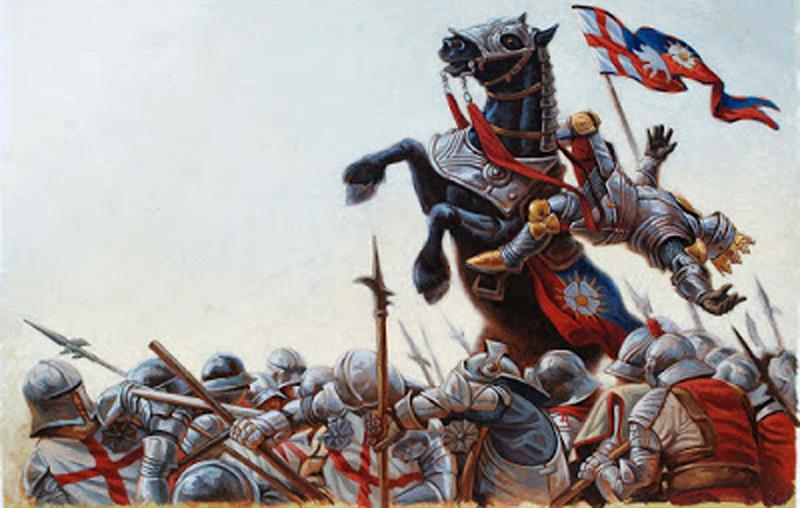
 Extracting power from English history, this multi-character play is set in England to unite the War of Roses. Little can soften the impact of Shakespeare’s blazing melodrama when the first scene reveals Richard limping downstage to reveal himself in a soliloquy that begins, ‘Now is the winter of our discontent. Made glorious summer by the sun of York’. Richard has to dispose six people between him and the throne when his dying brother, Edward IV has gone. When he takes over the crown, he has removed only one of them; the others he will deal with later.
Extracting power from English history, this multi-character play is set in England to unite the War of Roses. Little can soften the impact of Shakespeare’s blazing melodrama when the first scene reveals Richard limping downstage to reveal himself in a soliloquy that begins, ‘Now is the winter of our discontent. Made glorious summer by the sun of York’. Richard has to dispose six people between him and the throne when his dying brother, Edward IV has gone. When he takes over the crown, he has removed only one of them; the others he will deal with later.
First comes the dissimulation with his elder brother, the Duke of Clarence. By playing on Edward’s fears, he has sent Clarence to the Tower. Having seen this done and affected great concern, he meets the bearers of the coffin of Henry VI, the king he had already murdered followed by his daughter-in-law, Lady Anne. Out of mischief or masochism or both, he woos her over the coffin. She yields and Richard gloats.
 Next he stirs trouble at Court while the former Queen Margaret who unhistorically, still prowls about. She releases some of her fiercest invectives. Clarence by Richards’s order and spite of a royal pardon is murdered in the Tower and his corpse is pushed into a barrel of sweet wine.
Next he stirs trouble at Court while the former Queen Margaret who unhistorically, still prowls about. She releases some of her fiercest invectives. Clarence by Richards’s order and spite of a royal pardon is murdered in the Tower and his corpse is pushed into a barrel of sweet wine.
To Richard’s credit, many reason out that he has been misjudged, especially over the death of young Edward V and his brother. They suggest that the boys may have been killed by someone also wishing to please Richard, or even that they may have outlived him and were killed by Henry VII.
It is very unlikely that any real or new evidence for either side would appear. The bones of the children were found buried under a staircase in the Tower during the time of King Charles 11 and reburied in West Minister Abbey. They are probably the princes’ (What other children would be buried there?) But they obviously cannot unravel the mystery as to who gave the order to kill the princes.
PRINCES AT THE TOWER
A very sad moment in English history and an act that can never be forgiven or forgotten, but then Richard had a heart of granite. Overwhelmed by Clarence’s death, King Edward dies. The young Prince of Wales is to be brought from Ludlow. By then, Richard and his associates, notably Buckingham have begun to direct affairs as they wished. When the Prince arrives, he and his younger brother, the Duke of York are ‘lodged’ in the Tower, presumably until the coronation.
Various men of the Queen’s party, dangerous to Richard, are executed, among them at a few minutes’ notice the rash Lord Hastings. Buckingham is primed and gets the Lord Mayer and citizens of London to urge an apparent unwilling Richard to accept the throne. Once crowned, Richard does all he can to safeguard himself such as inciting Tyrrell to procure the death of the Princes in the Tower.
VENGEANCE ON THE GRUESOME MURDER
Seized by compassion, Tyrrell is against this act. Suspecting that Richard has got rid of Anne, he rises against this limping panther who knows only the taste of blood though evilly debonair and who possessed a glittering irony and a frightening rage. The demonic creature he was, he spared nothing that stood between him and the throne. He was planning to marry Elizabeth, Edward IV’s daughter. However, Buckingham revolts against him, raising an army. Henry, Earl of Richmond lands from France. Richard, encircled by enemies, fights to keep the throne.
He goes to battle and confronts the invader at Bosworth Field near Leicester. Buckingham has been captured and executed. But Richard is harassed by ghosts of his victims and fights desperately, screaming, “A horse; A horse. My kingdom for a horse,” only to be defeated and killed. Everything ends well with Richmond’s decision to marry Elizabeth and unite the red and white roses.
The division between the first half of Shakespeare’s career and the second is too hard to place precisely but several things make the turn of the century a useful marker. The Lord Chamberlain’s Men moved to the Globe in 1599 and in the same year, the Privy Council banned the publication of verse satire so that the theatre reaped the benefit as the satirists, popular with the public, turned to drama. This changed the theatrical scene as did the resurgence of the children’s companies from 1600 upwards. For the first eight years of the new century Shakespeare worked mainly with tragedy. English history no longer figured unless one counts King Lear set in ancient Britain which proved politically awkward and in any case Shakespeare had used up the best material.
However, the average reader who is not into the Bard’s work will find Richard 111 extremely difficult to digest unless he reads all parts of Henry VI to VIII.
